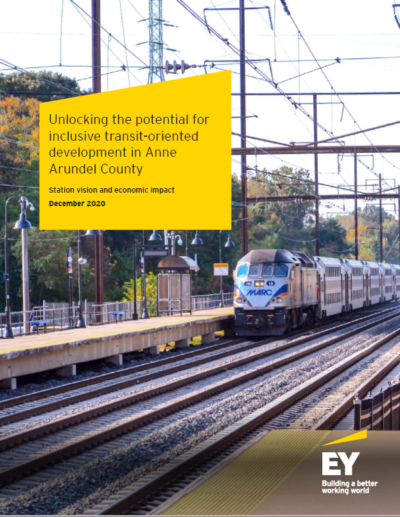Unlocking the potential for inclusive transit-oriented development in Anne Arundel County
Publish Date: December 2020

 Download Report »
Download Report »
Transit-oriented development (TOD) integrates public transportation options and relatively dense mixed-use development. This report examines TOD potential near rail stations in Anne Arundel County, Maryland (Anne Arundel or County) and identifies barriers to development. It also includes potential solutions and case study examples of TOD success achieved by other communities. Lastly, to further illustrate the potential benefits of additional TOD, this report presents hypothetical new developments and the potential economic impacts by highlighting three specific station areas in the County (Odenton, Cromwell-Glen Burnie and Laurel Racetrack) that currently have strong potential for TOD, and provides options for policy- and market-based efforts to encourage inclusive mixed-use development at those stations.
Today, deficiency of funding, absence of an integrated and coordinated vision and a lack of an easily accessible and reliable transit system within the County present significant barriers to successful TOD implementation. The study presents potential actions to overcome these barriers and increase TOD in Anne Arundel. The findings are supported by over 30 interviews with local stakeholders; a qualitative evaluation of existing County strategies and applicable regulations, statutes and zoning codes; and a quantitative data analysis to assess near-term readiness for TOD and market potential.
To increase funding, where possible the government stakeholders could consider two steps: bundling tax credits that encourage both development and job creation, and streamlining the permitting, fee waiver and approval
processes. In addition, existing state and local incentive programs, such as the More Jobs for Marylanders (MJM) tax credit and tax increment financing (TIF), could be expanded to TOD-designated areas. This could provide
broader applicability and flexible use of these programs. TOD could also be enhanced further by layering federal level incentives where possible and seeking public-private partnerships (PPP).
To establish a stronger, integrated and coordinated vision, the County could work collaboratively with the state, local municipalities and private stakeholders to ensure a mutual benefit to all parties. This strategic integration would benefit landowners, businesses and the community, promoting a shared vision that would support the shared success of TOD.
The commuter rail, light rail and bus stations that connect the County’s communities may need to be improved to promote reliable, accessible and safe transportation. The infrastructure surrounding most stations is often not effectively designed to support modern TOD expectations and developments, often lacking street grids, pedestrian walkways and adequate parking structures. Without these upgrades, TOD lacks transit orientation and differs little from the non-transit-oriented mixed-used development that struggles to connect people with the jobs and social activity that can encourage relocation into the County.